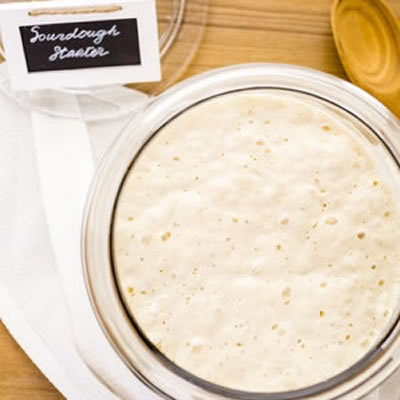
Sourdough Starter
What is Sourdough Starter?
Sourdough starter is the biochemical leavening agent which replaces added yeast in sourdough bread. These starters are responsible for the unique flavor and aroma of artisan, rustic-type sourdough breads.
- In simple terms, a sourdough starter is a mixture of flour, water and the most precious ingredient of all: time.
- Flour (carbon source) + Water + Mixing (air incorporation) + Time → Sourdough starter
Origin
Sourdough starters originated in Egypt when ancient Egyptians would reserve small pieces of dough to help with the next day’s bake. Bakers who had lighter and larger breads became better known for their starters, and were encouraged to keep them active to bake more products.
How is a sourdough starter made
Typical formulation of lean or basic sourdough starter:
| Ingredient | Baker’s % (based on flour weight) |
|---|---|
| White flour from hard wheat* | 100.0 |
| Water | 80.0 (viscous, very loose dough) – 100.0 (almost liquid consistency) |
| Total | 180.0 – 200.0 |
* Whole wheat flour and rye flour (dark) can be used for better flavor and superior product aroma
After being mixed and stored for several hours, even days, the hydrated and carbohydrate-rich mixture provides the perfect conditions for endogenous microflora present in flour, plus airborne wild yeasts and bacteria, to thrive, reproduce and carry out metabolic processes, such as alcoholic, lactic and acetic fermentation.
During sourdough starter preparation, organic acids and other secondary metabolites are produced and accumulated in the starter, causing a marked pH drop thus providing the characteristic aroma and flavor compounds.
Application
Stages for sourdough starter preparation:
- Flour and water mixing. Water should be filtered or low in residual chlorine to allow microorganisms to grow once mixed with flour.
- Storage in a container at room conditions (not refrigerated).
- Lag phase with no apparent cell growth → Before reproducing, yeast and bacteria cells first adjust to environment conditions (pH, temperature, water activity).
- Log / exponential phase (cell growth) → Cells reproduce exponentially due to availability of carbon sources and oxygen from air incorporation during flour/water mixing. This stage is all about providing the right conditions for cells to reproduce. In order to move to the next stage, living cells must increase in number to reach the dozens of millions per gram or mL.
- Fermentation (ripening or maturation) phase → Yeast and bacteria cells no longer reproduce at the initial high rates once oxygen and carbon source become scarce and stress factors are increased due to accumulation of waste materials. Alcoholic and lactic acid fermentation as well as alternate metabolic pathways are initiated.
- Final stage → Sourdough starter becomes fully mature and quickly expands to become very bubbly and foamy soon after being refreshed. From here, the starter is ready to be used for making bread.
Refreshing of sourdough starters
A strong sourdough starter for leavening bread dough takes several days to be ready. Stages 4 and 5 usually take about 90% of total time needed for the making of the starter. Stage 5 is the reason why sourdough starters must be refreshed periodically or receive a “bath.”
The refreshment or bath is a repetitive and periodic addition of fresh flour and water on top of the original starter mixture. By adding more water and flour and remixing, fresh nutrients and oxygen are incorporated into the starter so waste compounds are diluted. Cells are diluted as well after each bath so water and flour quantities must be carefully established based on the amount of starter available.
Functionality of sourdough starters in breadmaking1,2
- Help extend the (mold-free) shelf life of baked goods
- Extend the softness of bread thanks to its natural load of fungal and bacterial enzymes (mainly amylases and proteases)
- Increase the digestibility and bioavailability of nutrients in the finished product, a result of high phytase activity in the starter
- Decrease the glycemic index of bread
- Enhanced aroma and flavor of baked goods
References
- Corsetti, A. “Technology of Sourdough Fermentation and Sourdough Applications.” Handbook on Sourdough Biotechnology, Springer Science+Business Media New York, 2013, pp. 85–103.
- Quan Liu, S. “Sourdough.” Bakery Products Science and Technology, 2nd edition, John Wiley & Sons, Ltd, 2014, pp. 511–521.

